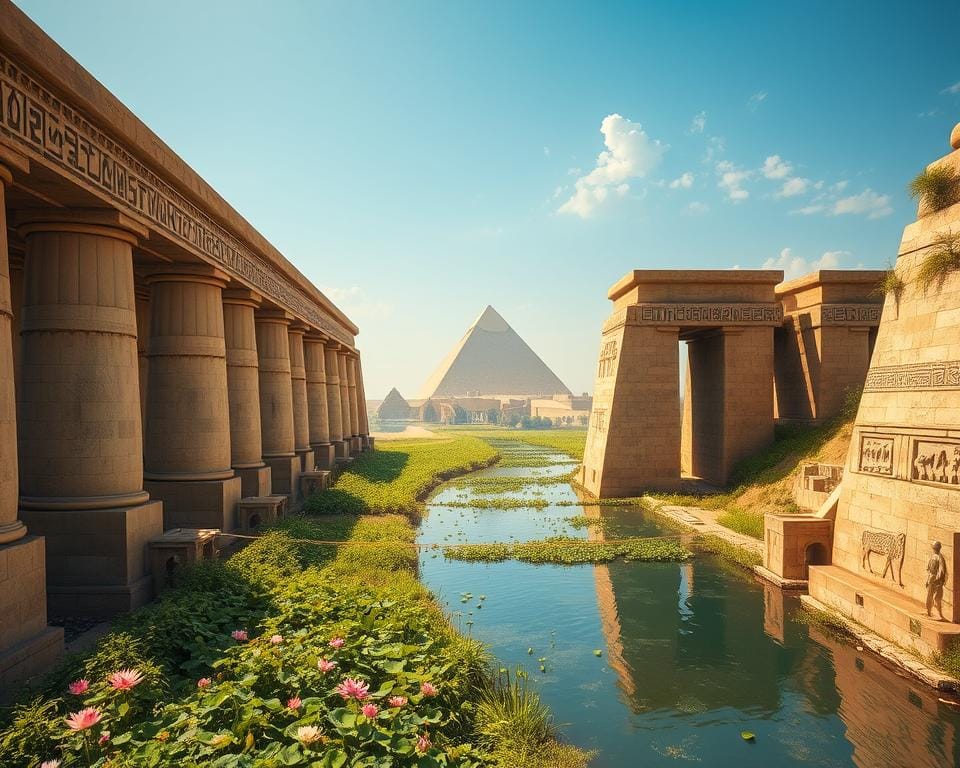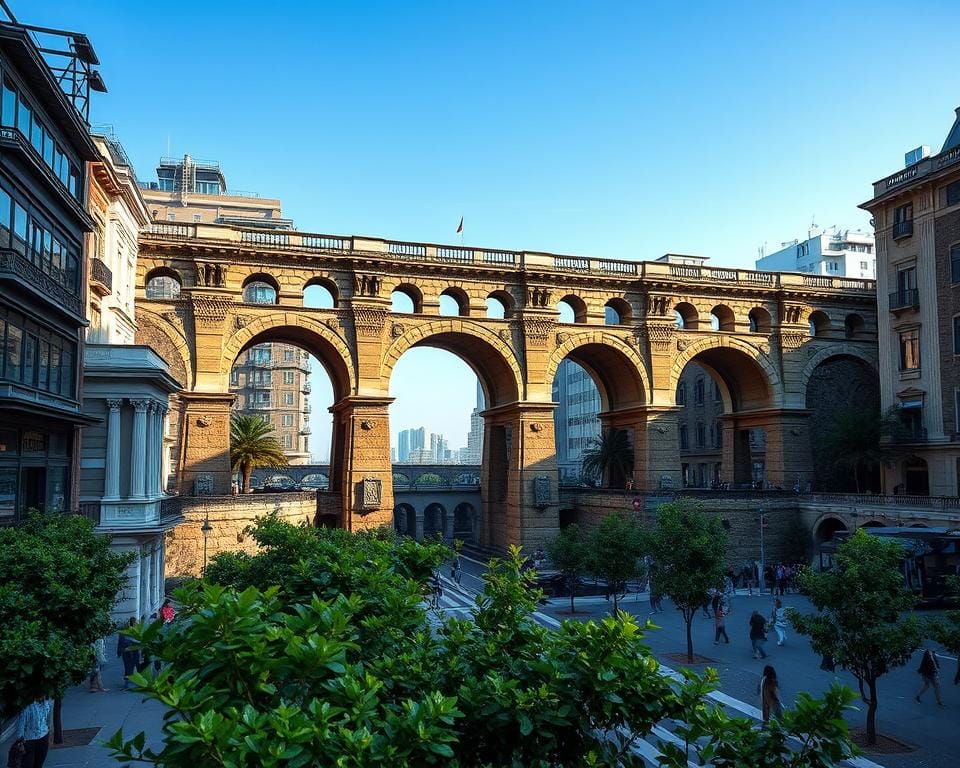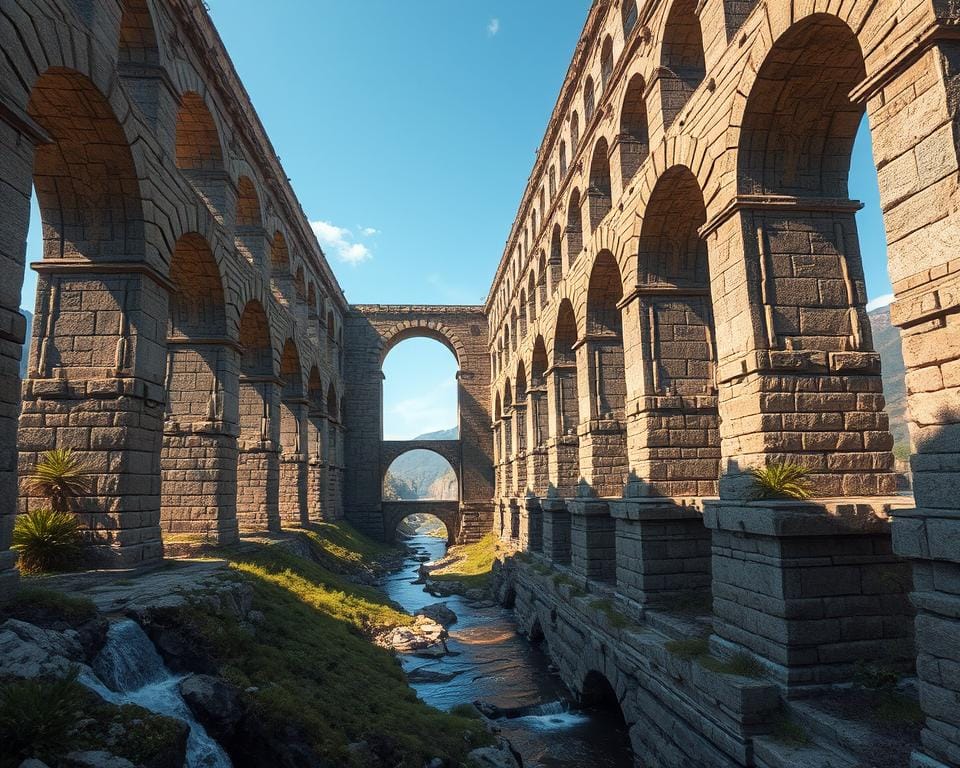Historic aqueducts showcase ancient engineering and water management skills. Especially, the Roman aqueducts were marvels, reaching across France, Spain, Greece, North Africa, and Turkey. These structures were crucial for supplying water for drinking, farming, and public spaces like fountains and baths.
Roman aqueducts were funded by public and private sources. Important rulers such as Augustus, Caligula, and Trajan often initiated these projects. For instance, the Aqua Virgo, constructed in 19 B.C.E., demonstrates Roman engineering skill. It still provides water to the Trevi Fountain in Rome.
The importance of these aqueducts is immense as they supported city growth and public health. They ensured cities had a steady water supply. The innovative use of Roman pozzolanic concrete highlights their lasting durability and innovation.
The Engineering Marvel of Roman Aqueducts
The Roman aqueducts were brilliant in ancient water transport. They met the growing needs of cities by using gravity. These aqueducts show the Romans’ ability to merge engineering with architecture, lasting through centuries.
Introduction to Roman Aqueducts
Roman aqueducts showcase careful planning and investment from over five centuries. They featured pipes, tunnels, and bridges. These elements worked with nature to move water over long distances smoothly.
Thanks to aqueducts, cities grew, health improved, and leisure became part of life. Their design still influences engineers today.
Construction Techniques
The building of the Roman aqueducts was a major task. It involved many workers and strong materials like stone. These choices ensured the aqueducts would last a long time.
The engineers made sure the aqueducts sloped gently. This kept the water moving without extra help. Every 230 feet, there was an inspection point to catch any leaks.
Building these aqueducts was expensive. Back then, it cost a lot to make each kilometer. This shows how important a stable water supply was to the Romans.
Famous Roman Aqueducts
Eleven major aqueducts were built. There were also some smaller ones. The Aqua Marcia was impressive, supplying a lot of water to public baths.
These aqueducts didn’t just support cities. They also helped mines in the Alps. Beyond their main role, they inspired future generations in water management.
Comparing with modern times, the cost of old and new water projects shows huge changes. For detailed study on ancient and modern water systems, click here.
Other Ancient Civilizations and Their Aqueducts
Roman aqueducts are well-known for their amazing engineering. But, it’s just as important to recognize the incredible water transport achievements of other ancient civilizations. Ancient Egyptians and Indians created advanced hydraulic systems. These systems showcased their engineering skills and knowledge of water management. Even though these are less known than Roman work, they were very important to their societies.
Egyptian Aqueducts
The ancient Egyptians were experts in managing water. They used the Nile River’s floods to help them. The Ancient Egyptian waterworks had basins and canals. These helped move floodwater from the Nile for farming. This method, called basin irrigation, greatly improved their agriculture and helped their civilization grow.

This water system did more than just help with farming. It also made sure people had water every day. This was a big step forward in how the Egyptians managed water. Their work with water control set the stage for future civilizations to come up with even better solutions.
The Innovations of Indian Aqueduct Systems
India also made great strides in aqueduct systems. Indian engineers made complex water systems to meet community needs. They built canals and reservoirs to bring monsoon water to dry areas. This let them irrigate land and supply water all year long.
A key example of their work is the Grand Anicut. It’s a dam across the Kaveri River in Tamil Nadu, built in the 2nd century AD. This dam helped with irrigation and showed the advanced nature of Indian aqueduct work. Its success in managing water resources showed a deep understanding of hydraulic science and engineering skill.
Famous Aqueducts from Around the World
Throughout history, aqueducts have been crucial for their role in water transport and remarkable architecture. These ancient waterways show the impact on various cultures, stressing the need for their preservation.
Pont du Gard (France)
Pont du Gard, in South France, stands as a testament to Roman expertise. It is 49 meters tall and stretches 275 meters. This impressive structure was crucial for ancient Romans, aiding their water needs. Over time, it also collected tolls and helped bridge roads. This highlights the ongoing importance of preserving such aqueducts.
Aqueduct of Segovia (Spain)
The Aqueduct of Segovia showcases Roman engineering with its 15 kilometers length, 28 meters height, and 167 arches. It’s not just a water conduit but also a stunning monument, emphasizing preservation. Situated in Segovia’s heart, it keeps amazing people, blending seamlessly into the urban scene for centuries.
Valens Aqueduct (Turkey)
Constructed in the late fourth century AD in Istanbul, the Valens Aqueduct stretches over 920 meters. It served Byzantine and Ottoman empires, showing ancient engineering feats. This aqueduct highlights the cultural and architectural importance of historical waterways. Keeping it preserved is key for Istanbul’s heritage.
| Aqueduct | Location | Key Features | Height | Length | Construction Era |
|---|---|---|---|---|---|
| Pont du Gard | France | Three levels of arches | 49 meters | 275 meters | 1st century AD |
| Aqueduct of Segovia | Spain | 167 arches | 28 meters | 15 kilometers | 1st century AD |
| Valens Aqueduct | Turkey | Byzantine and Ottoman utility | NA | 920 meters | 4th century AD |
The Societal Impact of Historic Aqueducts
Historic aqueducts have been key in shaping societal change. They helped cities grow and improved public health. For example, the Roman aqueducts, built from 312 BCE to 226 CE, were amazing feats of engineering. They changed ancient civilizations dramatically.
Urban Development

Aqueducts changed how cities developed. The Aqua Appia, from 312 BCE, started Rome’s advanced water systems. These structures allowed cities to grow fast and support many people.
Roman aqueducts could be over 50 miles long. They used the land’s slope to move water. This had a big impact: it meant water for farming, businesses, and daily life. This led to prosperity that came from having enough water.
Public Health Improvements
Aqueducts made big strides in public health long ago. They made sure people had clean water, cutting down on diseases from water. Cities in Rome got public baths and sanitation, making life better.
The Baths of Caracalla were places for socializing and staying clean. Rome also had beautiful public fountains. These features showed how societies were changing. They improved health and the overall quality of life.
The Enduring Legacy of Historic Aqueducts
The lasting impact of aqueducts shows the skill and creativity of ancient people, especially the Romans. These old waterways still amaze us with their enduring designs. They were built knowing a lot about water and building methods, using stone, brick, concrete, and lead.
The Roman innovation in these aqueducts is hard to ignore. Take the Aqua Claudia. It was over 68 miles long and brought millions of gallons of fresh water to Rome every day. It used gravity to move water easily, without needing pumps. This smart design helped cities grow in the Roman Empire.
Aqueducts also improved public health significantly. They had sand filters and tanks to clean the water. This meant fewer diseases from dirty water. These systems also helped with farming, industries, and supported city life, allowing big cities to expand.
The Familia Aquarum, including 460 people, cared for Rome’s aqueducts. This group showed how important water systems were to society and politics.
Today, we can still see the aqueduct legacy at places like the Pont du Gard in France. It has many arches and is well-built. And the well-kept aqueduct in Segovia, Spain. These sites let us see the great engineering of the past, a legacy that still teaches and inspires us.
Historial Significance and Preservation of Aqueducts
Aqueducts have a deep historical value, inspiring efforts to save and restore them. Their restoration is not just about fixing structures. It’s also about preserving their archaeological importance.
The Kaikos-waterline in the Pergamon Micro-Region shows ancient engineering skill with about 40 aqueducts over 50 km. The Karkassos Aqueduct is especially impressive. It’s 550 meters long, 40 meters high, and was used for around 60 years. Earthquakes and floods during that time left marks on it that we can still see through sinter analysis.
Preserving these ancient structures is about protecting them from time and environmental damage. New dams have changed landscapes and impacted archaeological sites. For example, Allianoi, a valuable heritage site, was flooded by dam waters. This shows the hard battles in heritage conservation.
These efforts in preservation help people connect with history. The Pont du Gard is a UNESCO World Heritage Site. It shows off architectural beauty and humanity’s creative spirit. Keeping these sites intact lets future generations explore history through tours and learning programs.
The comparison of water use in ancient Rome shows how important aqueducts were. According to Frontinus, Rome needed over 300 million gallons of water a day for its people. Each person used about 20 to 25 gallons, though modern guesses say it could be 55 gallons each day.
The building of old waterlines and new dams has been key to supplying water. This has supported agriculture, building, and drinking needs over time. It shows the ongoing importance of managing water for people’s needs. This underlines the huge value and archaeological impact of aqueducts throughout time.
To learn more about these aqueducts, check out aqueduct engineering. You can also get a thorough look at historical preservation at water conservation insights.
Conclusion
Reflecting on historic aqueducts shows their crucial role in civilization. They were vital in the progress of societies. Structures from Rome to Egypt and India are not just relics. They show the early engineers’ genius and dedication. For example, ancient civil engineering brought us Lisbon’s Aqueduct. It stretches over 58 kilometers with 35 arches, some as tall as 65 meters.
Roman aqueducts introduced stone, brick, and concrete. These materials set the stage for our water systems today. Their slight slope and arches helped cross valleys and rivers. Like the Pont du Gard shows, they used a smart gradient. This provided steady water for health, cities, and farms.
These aqueducts did more than move water. They boosted public health with baths and fountains in Rome. Cities like Lisbon tackled water shortages, leading to growth and better lives. The Mãe d’Água Reservoir in Lisbon, with its beautiful tiles, shows their dual purpose.
In conclusion, aqueducts are key parts of our heritage. They are symbols of lasting impact and creativity. They continue to attract tourists and researchers, showing ancient engineering’s role in today’s society. The Lisbon Aqueduct, with its history and architecture, draws many wanting to see its legacy.

